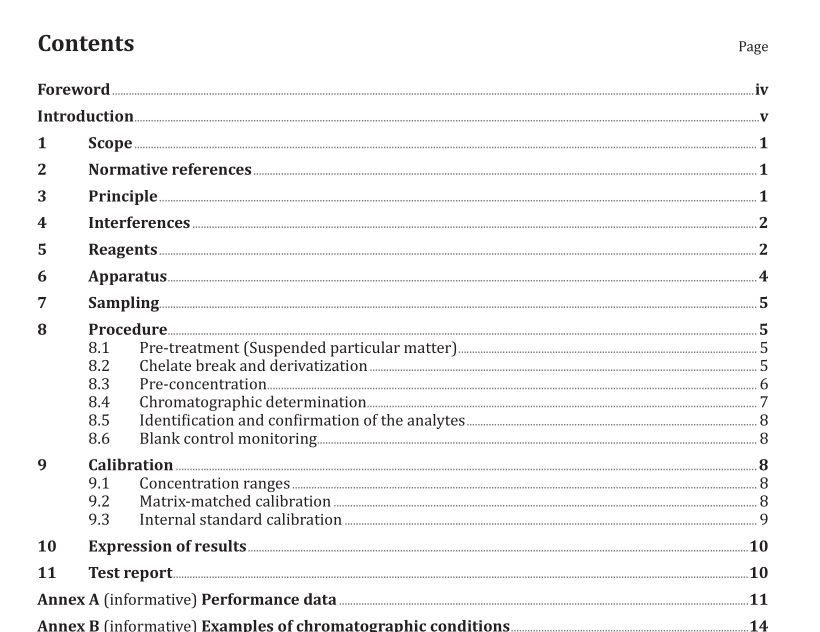ISO 16308 pdf download

ISO 16308 pdf download Water quality — Determination of glyphosate and AMPA — Method using high performance liquid chromatography (HPLC) with tandem mass spectrometric detection
1 Scope
This International Standard specifies a method for the determination of dissolved fraction of glyphosate and its major metabolite, aminomethylphosphonic acid (AMPA), in drinking water, ground water, and surface water at concentrations of 0,03 µg/l to 1,5 µg/l. It does not apply to marine or salty water. This method can be applicable to other types of waters, provided the method is validated for each case.
2 Normative references
The following documents, in whole or in part, are normatively referenced in this document and are indispensable for its application. For dated references, only the edition cited applies. For undated references, the latest edition of the referenced document (including any amendments) applies.
ISO 3696, Water for analytical laboratory use — Specification and test methods
ISO 5667-3, Water quality — Sampling — Part 3: Preservation and handling of water samples
ISO 8466-1, Water quality — Calibration and evaluation of analytical methods and estimation of performancecharacteristics — Part 1: Statistical evaluation of the linear calibration function
3 Principle
Glyphosate and AMPA (dissolved fraction after filtration) are derivatized using 9-fluorenylmethylchloroformate (FMOC-Cl) (5.17) to lower their polarity and increase the retention of compound in a separation on a reverse phase column (e.g. C18) as well as to improve the mass spectrometric detection. If the mass spectrometer has sufficient detection capability, it is possible to omit the solid phase extraction and to analyse the analytes by direct injection (see 8.2.1).
The derivatized sample is purified by liquid/liquid extraction and then concentrated by solid phase extraction (SPE).
The analysis is performed by high performance liquid chromatography coupled with tandem mass spectrometry via an electrospray source (HPLC–ESI–MS/MS), using matrix-matched calibration.
4 Interferences
This method is validated for hard water containing up to 3,2 mmol/l of the sum of calcium and magnesium. For waters with a higher calcium and magnesium content, it may be necessary to increase the concentration of EDTA-Na 2 (5.16) at the derivatization step (see Annex D).
It can prove necessary to include the acidification step described in Annex D even for some water types below 3,2 mmol/l of the sum of calcium and magnesium. The laboratory shall check the necessity of this procedure for its routine samples.
The presence of free chlorine, e.g. in treated waters, can cause losses of glyphosate by oxidation.
Consequently sodium thiosulfate shall be used (see Clause 7).
5 Reagents
Unless otherwise stated, all reagents and solvents shall be of sufficient purity, e.g. “for trace analysis”.
5.1 Deionized water.
5.2 Ultra-pure water, complying with grade 1 of ISO 3696.
5.3 Nitrogen, N 2 , purity ≥ 99,996 % volume fraction.
5.4 Laboratory detergent, alkaline.
5.5 Sodium thiosulfate, Na 2 S 2 O 3 .
5.6 Acetonitrile, C 2 H 3 N, HPLC grade.
5.7 Methanol, CH 4 O, HPLC grade.
5.8 Ethanol, C 2 H 6 O, 95 %, HPLC grade mass fraction.
5.9 Ethyl acetate, C 4 H 8 O 2 , HPLC grade.
5.10 Ammonium acetate, C 2 H 7 O 2 N.
5.11 Triethylamine, C 6 H 15 N.
5.12 Ammonium hydroxide, NH 4 OH , 28 % mass fraction.









